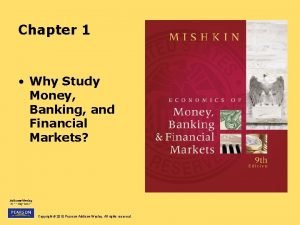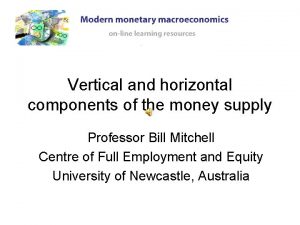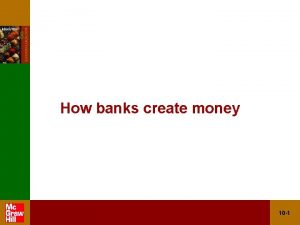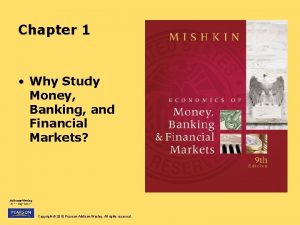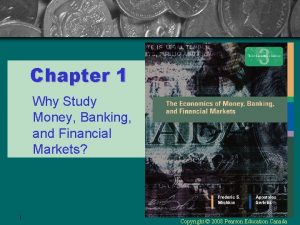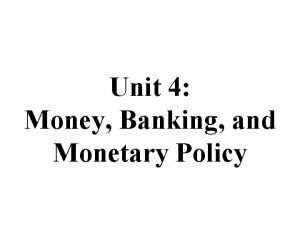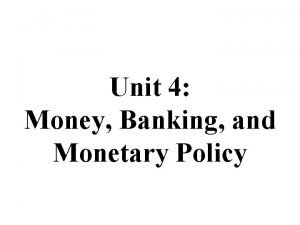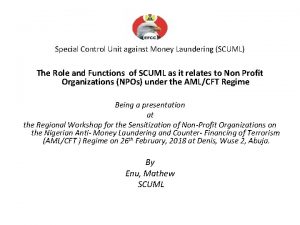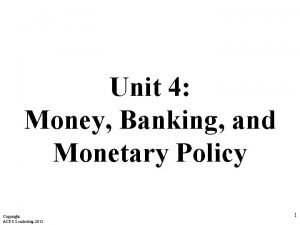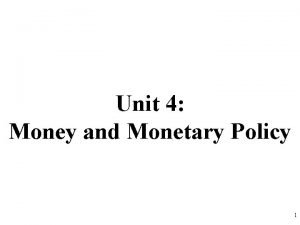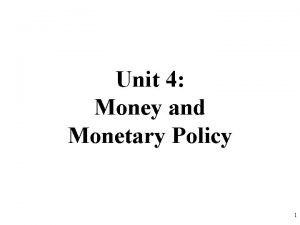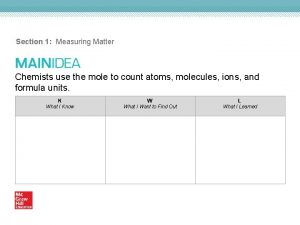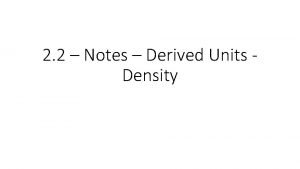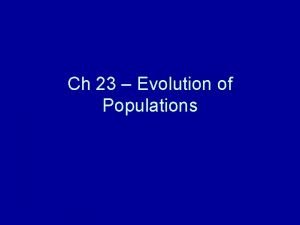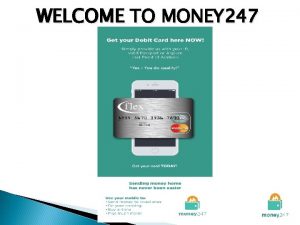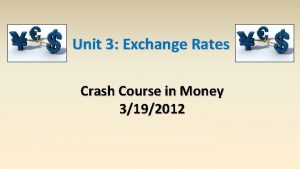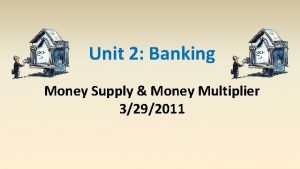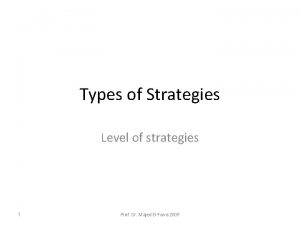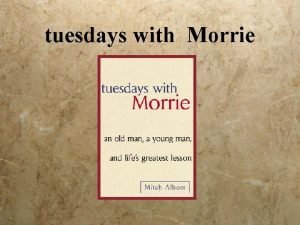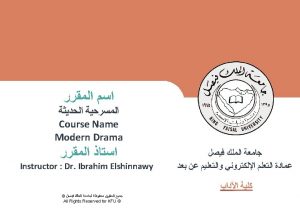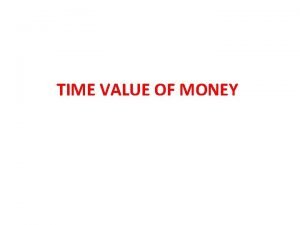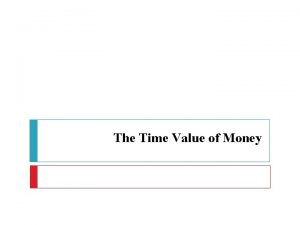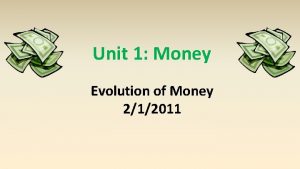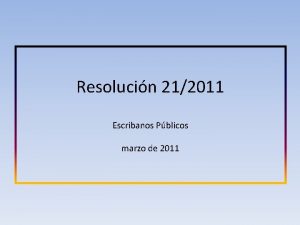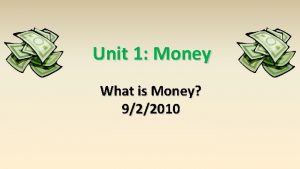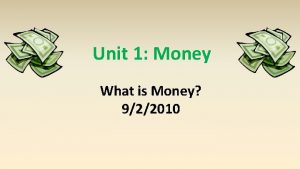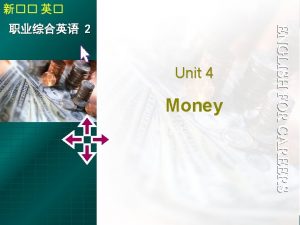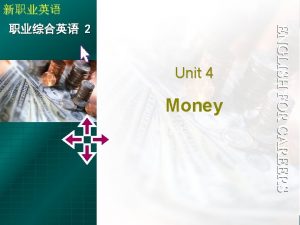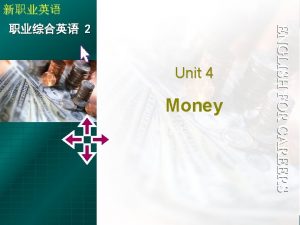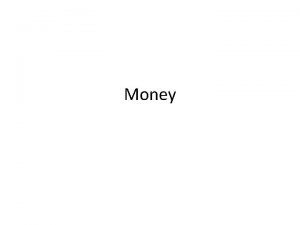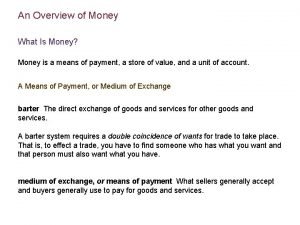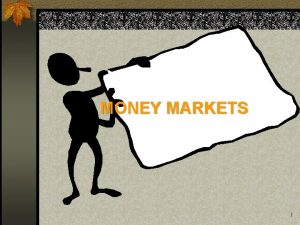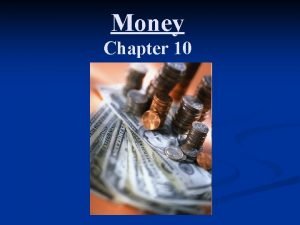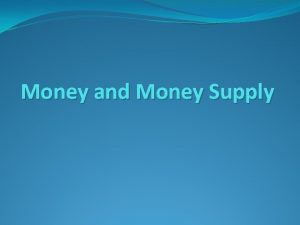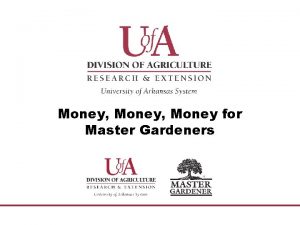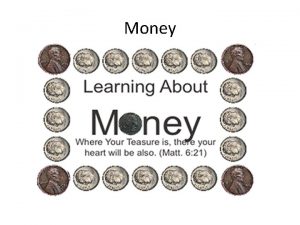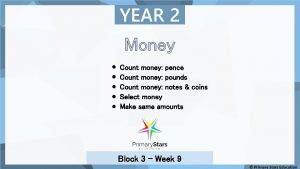Unit 1 Money What is Money 212011 Why



















































- Slides: 51

Unit 1: Money What is Money? 2/1/2011

Why Trade? Adam Smith detailed the benefits of specialization and division of labor in his book The Wealth of Nations. Each worker could become an expert in a small area, greatly increasing efficiency.

Why Trade? David Ricardo Law of Association (comparative advantage) – Even if someone is absolutely more productive at 2 activities, if he is comparatively more productive at 1 activity than another relative to a 2 nd person, he will be better off specializing and trading than producing in isolation.

Why Trade? Tom is better off specializing and trading even though he has an absolute advantage.

production possibilities frontier Person Food Andy 100 Bob 400 Total 500 production possibilities frontier Why Trade? Specializing and trading here gains 50 food. Person Clothes Andy 100 Bob 200 Total 300 consumption + production in autarky Person Food Clothes production after trade Person Food Clothes consumption after trade Person Food Clothes Andy 50 50 Andy 0 100 Andy 75 50 Bob 200 100 Bob 300 50 Bob 225 100 Total 250 150 Total 300 150

Valuing Goods We must distinguish between price and value: price is objective value is subjective

Valuing Goods When people trade, the price they see is the same. However, they do not value the items traded equally. Instead they value the items unequally. = ≠ There is a reverse inequality of value.

Valuing Goods reverse inequality of value – both parties to the trade value what they’re getting more than what they’re giving up (everyone is happy)

Valuing Goods Suppose Harry wants to trade a hat to Bob for a haircut. If the trade occurs, Harry values haircut > hat Harry the haberdasher Bob values haircut < hat Bob the barber

Valuing Goods Reverse inequality of value is what makes trades mutually advantageous, which is why people trade voluntarily. Trade is not a zero sum game with a winner and a loser. Trade is a positive sum game. Both parties are winners. Harry Bob

Valuing Goods Remember the insight that people only enter into voluntary trades if they subjectively believe they are made better off. For example, sweatshop employees work there because the alternative would be worse.

Valuing Goods Gains from trade can be thought of graphically as consumer surplus and producer surplus.

Barter barter (direct exchange) – trade for something that can be used directly in consumption or production

Barter can work well when you easily find a parallel trader. In that case not using money actually saves a step.

Barter But often finding someone who has what you want and wants what you have is very difficult. Search costs and other transaction costs can be quite high.

Barter double coincidence of wants – each person must want the good his trading partner is offerring

Barter transaction costs – opportunity costs of finding a trading partner, negotiating a deal, and monitoring the terms

Barter Transaction costs of barter are so huge that it is very inefficient. Barter only exists where laws or social norms make efficient indirect trade difficult or impossible.

Barter places barter survives • to evade or reduce taxes • underground economy • marriage, dating, sex • new car (trade in old) • health/dental benefits (less taxes)

Indirect Exchange medium of exchange (indirect exchange) – something not wanted for commodity value, but rather for trade value

Indirect Exchange trader endowment preference B>A>C B-owner refuses to trade for A. C>B>A C-owner refuses to trade for B. A>C>B A-owner refuses to trade for C. A B C trades ends with

Indirect Exchange trader endowment preference trades B>A>C (1) A C (2) C B C>B>A B C A>C>B C A A B C ends with

Indirect Exchange The trades worked because a medium of exchange was used. (MOE) Here broccoli was the medium of exchange. But the medium of exchange could be anything. (MOE) ?

Money money – commonly accepted medium of exchange

Money When a circulating medium of exchange becomes commonly accepted (that is, widely adopted by most traders as the preferred media of exchange), it becomes money.

Money commodity money – money with a close relationship between money value and commodity value fiat money – money in which monetary value far exceeds commodity value

Historical Monies Many forms of commodity money have been adopted around the world. The commodity chosen tends to be the main production good or ornamental.

Historical Monies Where? Colonial Virginia What? tobacco

Historical Monies Where? West Indies What? sugar

Historical Monies Where? Abyssinia (Ethiopia) What? salt

Historical Monies Where? Ancient Greece What? cattle

Historical Monies Where? Midieval Iceland What? wool

Historical Monies Where? Scotland What? nails

Historical Monies Where? Ancient Egypt What? copper rings

Historical Monies Where? Native Americans What? Wampum (beads on a string)

Historical Monies Where? Island of Yap (South Pacific) What? Fei (large stone wheels)

Historical Monies Where? West Africa, China What? cowrie shells

Historical Monies Where? Aztecs What? caoca beans (chocolate)

Historical Monies Where? China, Mongolia, Siberia What? tea

Historical Monies Where? Mesopotamia What? barley (grain)

Historical Monies Where? Ancient Japan What? rice

Historical Monies Where? Colonial Australia What? rum

Historical Monies Where? prisons What? cigarettes

Functions of Money Main function of money • medium of exchange Subsidiary functions of money • medium of account • store of value • standard of deferred payment

Functions of Money unit of account – common numerator of all prices More properly: medium of account – good used as a pricing or accounting unit of account – specific quantity of the good used as a pricing or accounting unit

Functions of Money store of value – separates act of buying from selling (saving with low transaction costs) standard of deferred payment – money is a good way of paying back loans

Monetary Aggregates Money supply • MB – monetary base (total currency) • M 1 – very liquid assets • M 2 – somewhat liquid assets • M 3 – even less liquid assets • MZM – money with zero maturity

Monetary Aggregates Money supply MB = currency in circulation + reserves in bank vaults + reserves with the Fed M 1 = currency in circulation + travelers checks + demand deposits + other checkable deposits M 2 = M 1 + time deposits (<$100 k) + savings deposits + MMMF shares (individuals)

Monetary Aggregates Money supply M 3 = M 2 + time deposits (>$100 k) + MMMF shares (institutional) + short term RP agreements + other large liquid assets MZM = currency in circulation + travelers checks + demand deposits + other checkable deposits + savings deposits + all MMMF shares

Monetary Aggregates Notes • Only MB includes reserves. • M 3>M 2>M 1 • Fed stopped tracking M 3 in 2006

Stock vs. Flow wealth is a stock value (oz. Au) income is a flow value (oz. Au / year)
 Pictures
Pictures Money money money team
Money money money team Dont ask
Dont ask Unit 10, unit 10 review tests, unit 10 general test
Unit 10, unit 10 review tests, unit 10 general test Gatsby
Gatsby Money smart money match
Money smart money match Money on money multiple
Money on money multiple Great gatsby satire
Great gatsby satire The great gatsby historical context
The great gatsby historical context Money growth formula
Money growth formula Why study money
Why study money Money madness poem writer
Money madness poem writer Why is supply of money vertical
Why is supply of money vertical Why can banks create money
Why can banks create money Why study money banking and financial markets
Why study money banking and financial markets Why study money banking and financial markets
Why study money banking and financial markets Unit 4 money banking and monetary policy
Unit 4 money banking and monetary policy Unit 4 money banking and monetary policy
Unit 4 money banking and monetary policy Scuml meaning
Scuml meaning Unit 4 money and monetary policy
Unit 4 money and monetary policy Unit 4 money and monetary policy
Unit 4 money and monetary policy Unit 4 money and monetary policy
Unit 4 money and monetary policy Money advice unit stevenage
Money advice unit stevenage Why-why analysis
Why-why analysis Why do you cry willy tongue twister
Why do you cry willy tongue twister Does this table represent a function why or why not
Does this table represent a function why or why not What does a table represent
What does a table represent Why or why not
Why or why not Metode analisis akar masalah dan solusi
Metode analisis akar masalah dan solusi Unit 5 international business p6
Unit 5 international business p6 Why do chemists use the mole as a counting unit
Why do chemists use the mole as a counting unit Why is density a derived unit
Why is density a derived unit Smallest unit of evolution
Smallest unit of evolution Surplus keuangan adalah
Surplus keuangan adalah Hyp opp adj
Hyp opp adj Si units mass
Si units mass Unit test review algebra 2
Unit test review algebra 2 Contoh soal perhitungan unit cost rumah sakit
Contoh soal perhitungan unit cost rumah sakit Unit process and unit operation
Unit process and unit operation What is unit operation and unit process
What is unit operation and unit process Setiap unit akuntansi dianggap sebagai unit yang mandiri
Setiap unit akuntansi dianggap sebagai unit yang mandiri Pay money 247
Pay money 247 7elife
7elife Crown financial concepts
Crown financial concepts Real money balance formula
Real money balance formula Deposit creation
Deposit creation Liquidated money meaning
Liquidated money meaning Tuesdays with morrie the curriculum
Tuesdays with morrie the curriculum What is torvald's attitude toward borrowing money?
What is torvald's attitude toward borrowing money? Pv adalah
Pv adalah Mr pig and mr dog theme
Mr pig and mr dog theme Learning objectives of money
Learning objectives of money










